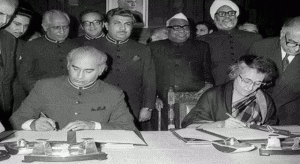On the day of 02 July 1972, Shimla Agreement was signed between Indira Gandhi and Zulfiqar Ali Bhutto at Shimla in Himachal Pradesh. Shimla Agreement is also known as Shimla Accord. The topic is important from the IAS Exam perspectives.

| To coverimportant subjects mentioned in the UPSC Syllabus, check the following links: |
Shimla Agreement – Background
The Shimla Agreement or Shimla Accord is an important part of Indo-Pakistan relations. It is a landmark in the bilateral relations between the two neigbouring countries. It comes under the international relations section of the UPSC Mains GS 3 Syllabus .
- The Shimla Agreement (also called the Shimla Accord or Shimla Treaty), signed between the premiers of India and Pakistan was a treaty that laid out the principles which would govern the future bilateral relations between the two countries.
- It was signed 8 months after the Indo-Pakistani war of 1971, that led to the splitting of Pakistan and the consequent creation of Bangladesh, had ended.
- The accord had contained the steps which were to be taken in order to ensure the normalisation of relations between India and Pakistan.
- The agreement was signed in Barnes Court (Raj Bhavan) at Shimla, Himachal Pradesh.
- The terms of the treaty were as follows:
- The Charter of the UN shall govern relations between India and Pakistan.
- Any differences shall be settled by peaceful means and through bilateral negotiations.
- Both countries shall respect the territorial integrity of each other and not interfere in the internal matters of each other.
- Forces shall be withdrawn to each other’s side of the international border.
- The ceasefire line of December 17th 1971 (after the Bangladesh War) shall be respected (and reiterated as the Line of Control).
- The treaty also had some other terms like renewing communications, telegraph, postal, airline relations, etc. It also talked about having exchanges in the field of culture and science.
- India released 93000 Pakistani prisoners of war (POWs) who were captured after the Bangladesh war.
- It is said that India had a vantage position after Pakistan’s crushing defeat but failed to capitalise on it. India could have pushed for a definitive solution to the border problem with Pakistan but did not do so and failed to leverage the POW situation. Despite the entire military leadership of erstwhile East Pakistan surrendering to Indian and Bangladeshi forces, and despite having captured strategic positions in Kashmir and about 5000 square miles of Sindh and Pakistani Punjab, India failed to settle relations with Pakistan once and for all.
- A few observers opine that India was keen to get Bangladeshi leader Sheikh Mujibur Rehman released from Pakistan.
- Pakistan did not keep its word and continue to unsettle India on the Kashmir issue. There was a severe war-like situation between both countries around Kargil in 1999.
- The Shimla Agreement did nothing much to improve relations between India and Pakistan.
See previous ‘This Day in History’ here.
Also see:
| Indus Water Treaty | History Questions for UPSC Mains GS 1 |
| Kargil War | International Relations Questions for UPSC Mains GS 3 |
| India – Pakistan relations | Topic-Wise GS 3 Questions for UPSC Mains |

Comments